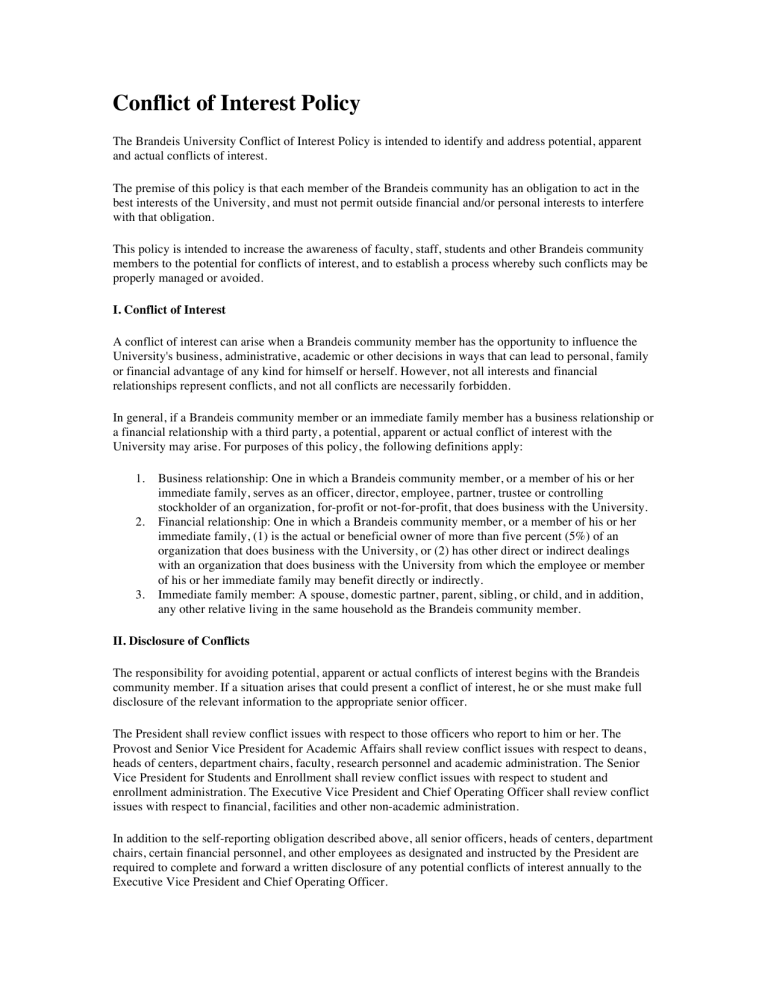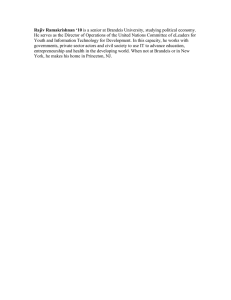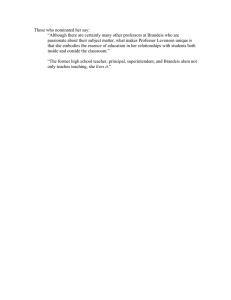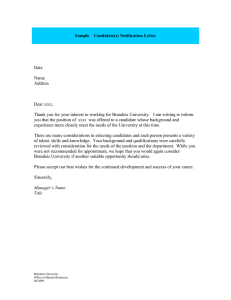Conflict of Interest Policy

Conflict of Interest Policy
The Brandeis University Conflict of Interest Policy is intended to identify and address potential, apparent and actual conflicts of interest.
The premise of this policy is that each member of the Brandeis community has an obligation to act in the best interests of the University, and must not permit outside financial and/or personal interests to interfere with that obligation.
This policy is intended to increase the awareness of faculty, staff, students and other Brandeis community members to the potential for conflicts of interest, and to establish a process whereby such conflicts may be properly managed or avoided.
I. Conflict of Interest
A conflict of interest can arise when a Brandeis community member has the opportunity to influence the
University's business, administrative, academic or other decisions in ways that can lead to personal, family or financial advantage of any kind for himself or herself. However, not all interests and financial relationships represent conflicts, and not all conflicts are necessarily forbidden.
In general, if a Brandeis community member or an immediate family member has a business relationship or a financial relationship with a third party, a potential, apparent or actual conflict of interest with the
University may arise. For purposes of this policy, the following definitions apply:
1.
Business relationship: One in which a Brandeis community member, or a member of his or her immediate family, serves as an officer, director, employee, partner, trustee or controlling stockholder of an organization, for-profit or not-for-profit, that does business with the University.
2.
Financial relationship: One in which a Brandeis community member, or a member of his or her immediate family, (1) is the actual or beneficial owner of more than five percent (5%) of an organization that does business with the University, or (2) has other direct or indirect dealings with an organization that does business with the University from which the employee or member of his or her immediate family may benefit directly or indirectly.
3.
Immediate family member: A spouse, domestic partner, parent, sibling, or child, and in addition, any other relative living in the same household as the Brandeis community member.
II. Disclosure of Conflicts
The responsibility for avoiding potential, apparent or actual conflicts of interest begins with the Brandeis community member. If a situation arises that could present a conflict of interest, he or she must make full disclosure of the relevant information to the appropriate senior officer.
The President shall review conflict issues with respect to those officers who report to him or her. The
Provost and Senior Vice President for Academic Affairs shall review conflict issues with respect to deans, heads of centers, department chairs, faculty, research personnel and academic administration. The Senior
Vice President for Students and Enrollment shall review conflict issues with respect to student and enrollment administration. The Executive Vice President and Chief Operating Officer shall review conflict issues with respect to financial, facilities and other non-academic administration.
In addition to the self-reporting obligation described above, all senior officers, heads of centers, department chairs, certain financial personnel, and other employees as designated and instructed by the President are required to complete and forward a written disclosure of any potential conflicts of interest annually to the
Executive Vice President and Chief Operating Officer.
All community members engaged in sponsored research are required annually to submit a disclosure of their significant financial interests (a term that is defined in the relevant federal regulations). The annual disclosures must be in writing, on forms approved by the University. Whenever an application for funding of a new research project is submitted, the researcher will be required to certify that he or she has submitted a complete and accurate annual disclosure, and that the new research project does not present the potential for any actual or apparent conflicts of interest not already identified in the annual disclosure.
Whenever any business relationships, financial relationships, significant financial interests or external activities change materially, the disclosures described above are to be updated as soon as possible, in writing. Whenever possible, community members should disclose expected changes or newly anticipated potential, apparent or actual conflicts at least thirty (30) days before they occur.
III. Resolution of Conflicts
In the event that a disclosure by a community member reveals a potential, apparent or actual conflict, the responsible senior officer or his or her designee shall review the facts and determine whether a conflict of interest exists. He or she shall determine the appropriate steps to take, and shall attempt to resolve the matter informally and privately with the community member, if possible. Removal or recusal of the community member from participation in any Brandeis decision- making process involving the potential conflict is generally the first step.
If the community member objects to the resolution plan, the senior officer may appoint an advisory committee, which shall include at least three Brandeis community members. In cases involving a member of the faculty, at least two of these committee members shall be senior faculty members. The advisory committee shall consider whether a conflict exists, evaluate the severity of the conflict and recommend to the senior officer the steps necessary, in its view, to resolve the conflict.
The senior officer may accept, reject or modify the recommendation of the advisory committee and shall make a final determination in writing. If the determination requires any adjustment or change in the community member's employment or student status, the procedures within the relevant Brandeis employment or student handbooks may be invoked.
IV. Examples
1.
A scientist uses his Brandeis laboratory to perform research, which is paid for by a company of which he is the founder and a 20% owner. This is a conflict of interest, which will not be permitted.
2.
An employee directs the purchase of supplies or services for the University toward a business in which he or his immediate family has a significant ownership interest, without an appropriate bidding process. This is a conflict of interest, which will not be permitted.
3.
A faculty member acts as dissertation advisor to a graduate student for a research project, suggested by the faculty member, that the faculty member expects to substantially enhance the value of a company in which the faculty member has a significant ownership interest. This is a conflict of interest, which will not be permitted.
4.
A friend of a Brandeis employee asks her for a favor. She would like her son to attend Brandeis. If the Brandeis employee will assist in ensuring that the son is accepted, the friend will use her influence to obtain admission to Harvard for the Brandeis employee's daughter. This is a conflict of interest, which will not be permitted.
5.
A faculty member performs research that has attracted the interest of a for-profit company. This company wishes to employ the faculty member as a consultant, receive advance information about her research, and obtain "first refusal" rights to license any inventions arising from that research.
This is an apparent conflict of interest, which may be permitted after the appropriate disclosures and business arrangements are made to protect the faculty member's and the University's business and intellectual property interests. A confidentiality agreement will be necessary, for intellectual
property reasons and also to emphasize that the purpose of a consulting agreement between a
Brandeis researcher and a company is to provide the company with top-level scientific thinking, not simply with a pipeline to the results of Brandeis research.
6.
A scientist who is a member of a company's scientific advisory board conducts research sponsored by that company. This is an apparent conflict of interest, which may be permitted after the appropriate disclosures and approvals.
7.
A researcher consults in the area of her professional expertise for a company that also makes a gift to support research in her department at Brandeis. This is an apparent conflict of interest, which may be permitted after the appropriate disclosures and approvals.
8.
An employee maintains a home-based business, working on weekends for non-Brandeis clients.
He is asked to perform services as a consultant on a Brandeis project in a different office. This is an apparent conflict of interest, which may be permitted after the appropriate disclosures and approvals.




